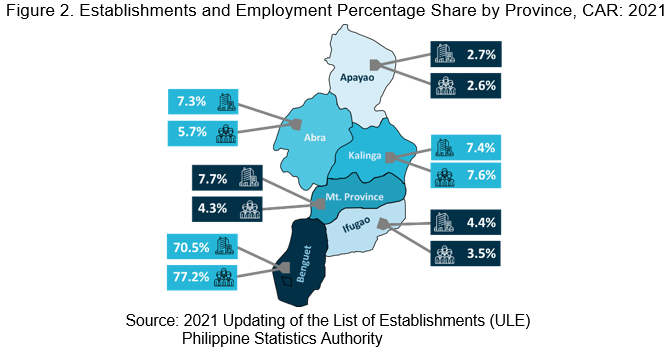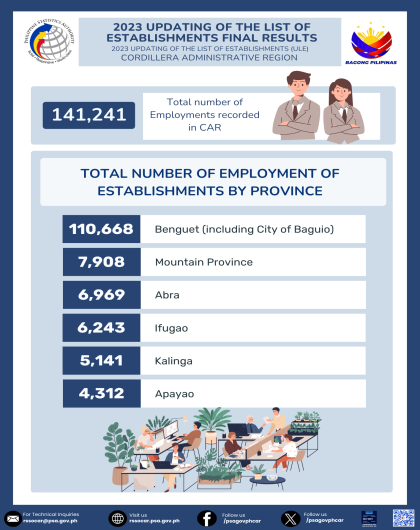The 2021 Updating of the List of Establishments (ULE) was conducted generally to update the status and characteristics of establishments in the Philippine Statistics Authority’s (PSA) List of Establishments (LE) and to provide information on the distribution of establishments and employment across areas and industries. In addition, the 2021 nationwide ULE was conducted mainly to assess the changes in business operations in the country brought by the pandemic and by some natural calamities. The LE serves as the source of sampling frame for all establishment-based surveys and censuses conducted by the PSA. Data presented in this special release are based on the comprehensive updating of the LE conducted in 2018 and 2021.
Establishments in Cordillera increase in 2021
- The number of establishments in Cordillera based on the 2021 List of Establishment (LE) recorded a total of 22,540 establishments during the pandemic with 10.1 percent growth from the 2018 LE in CAR. However, total employment in the region decreased by 12.3 percent or 14,963 less employed individuals from 2018 LE of 121,471 to 106,503 total employment in 2021. Number of establishments in the region was about 2.1 percent of the country’s total number of 1,080,810 establishments while the total employment in the region was 1.3 percent of the country’s total number of 8,445,578 employment (Figure 1 and Table 1).
- National Capital Region (NCR) recorded the highest number of establishments with 200,554. However, it decreased by 2.3% or 4,696 less establishments from the 205,250 in 2021. CALABARZON with 160,105 establishments came second, followed by Central Luzon with 138,032 recorded establishments.
- On the other hand, the following regions recorded the least number of establishments MIMAROPA (23,285), CAR (22,540), Caraga (22,614) and BARMM (7,963).
- Most of the establishments in CAR were engaged in services with 88.7 percent share, followed by industry with 10.9 percent, and agriculture with 0.4 percent.
Most establishments are in Benguet
- Across CAR, Benguet (including Baguio City) remained as the province with the highest number of establishments with 15,901. These establishments accounted 70.5 percent of the total establishments in the region. Establishments in Benguet employed 82,169 persons contributing 77.2 percent to the total employment in the Cordillera.
- Second highest recorded establishments was Mountain Province (1,728) contributing 7.7 percent followed by Kalinga (1,664) with 7.4 percent and Abra (1,643) with 7.3 percent. Ifugao (992) with 4.4 percent and Apayao (612) with 2.7 percent recorded the least number of establishments.
Apayao recorded highest growth of establishments
- Apayao recorded 70.9 percent growth from 358 recorded establishments in 2018 to 612 establishments in 2021. Second highest growth was Abra with 31.4 percent increase followed by Benguet with 8.8 percent, Mt. Province with 8.3 percent and Ifugao with 2.0 percent while Kalinga recorded a decrease of 0.6 percent.
- Employment in Apayao increased by 116.3 percent followed by Kalinga with 7.9 percent despite the decrease in the number of establishments. Mt. Province and Ifugao also recorded increases with 2.8 and 1.1 percent respectively.
- On the other hand, two provinces recorded decreases in employment with Benguet with -16.9 percent and Abra with -6.4 percent.
Wholesale and Retail Trade dominates establishment count in CAR
- Half of the establishments in CAR was engaged in Wholesale and Retail Trade; Repair of Motor Vehicles and Motorcycles with 11,388 establishments recorded which accounted 50.5 percent of the total establishments in the region. This was followed by Accommodation and Food Services activities with 16 percent share or equivalent to 3,621 establishments. Manufacturing came third with 2,274 or 10.0 percent share of the establishments recorded.
- About 25 establishments were engaged in Water Supply; Sewerage, Waste Management and Remediation Activities, while only 15 establishments were engaged in Mining and Quarrying.
Single proprietorship comprises 87.6% of total establishments in CAR
- As to legal organization, Single Proprietorship had the largest number with 19,744 establishments, sharing 87.6 percent to the total establishments in the region. Stock Corporation placed second with 7.8 percent share (1,766 establishments), followed by Cooperative with 2.2 percent (499 establishments), Non-Stock, Non-profit Corporation with 1.4 percent (332 establishments) and Others with 0.4 percent (84 establishments). Partnership and Government Corporations had the least number of establishments with 0.3 and 0.1 percent or 81 and 34 establishments respectively.
Micro enterprises are biggest employers
- Majority of the establishments in CAR or 94.0 percent were Micro Enterprises (1-9 employees) with 21,195 establishments recorded. These establishments employed about 50,757 persons that comprised 47.7 percent of the 106,503 total employment in the region.
- Large enterprises (200 and over employees) and small enterprises (10-99 employees) shared 24.4 percent (25,976) and 24.38 percent (25,968) respectively.
- Medium enterprises (100-199 employees) had the least number of establishments with 28 (0.1 percent) employing 3,802 workers or 3.6 percent of the total employment.
- The average number of employees per establishment size were: 2 workers in Micro, 20 workers in Small, 136 workers in Medium, and 553 workers in Large Scale Enterprises.
Technical Notes
Establishment is defined as an economic unit under a single ownership or control, i.e. under a single legal entity which engages in one or predominantly one kind of economic activity and at a single fixed physical location.
Ambulant peddlers and hawkers and movable stalls either along a public road or in a marketplace, as they do not have a fixed business location, are not considered as establishments.
Similarly, open stalls in shopping centers, malls and markets are not considered establishments as they do not have permanency of business location.
Individual professionals, technical workers or craftsmen who do not maintain fixed offices or shops are also excluded.
Legal Organization (LO) is the legal form of the economic entity that owns the establishment.
Single Proprietorship refers to a business establishment organized, owned and managed by one person, who alone assumes the risk of the business enterprise.
Partnership refers to an association of two or more individuals for the conduct of a business enterprise based upon an agreement or contract.
Government Corporation refers to a corporation organized for private aim, benefit or purpose with the government as the majority stockholder, regardless of whether they are stock or non-stock corporations.
Corporation refers to an artificial being created by operation of law, having the right of succession, and the powers, attributes and properties expressly authorized by law.
Stock Corporation refers to an ordinary business corporation organized by private persons, created and for the purpose of making a profit which may distributed to stockholders on the basis of their invested capital.
Non-stock, Non-profit Corporation refers to a business corporation which does not issue stock to its members and are created not to profit but for the public good and welfare.
Cooperative refers to an organization composed primarily of small producers and/or consumers who voluntarily join together to form a business enterprise.
Philippine Standard Industrial Classification (PSIC) is a detailed classification of industries prevailing in the country according to the kind of productive activities undertaken by establishments.









